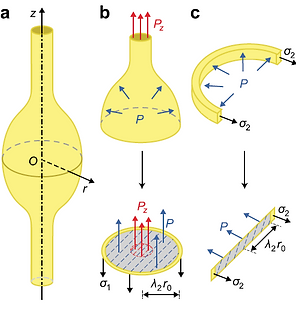Mechanical stress in a solid ellipsoid model of the lung after thoracoscopic surgery for spontaneous pneumothorax
with Byungho Lee and Chanbeom Park

Background: Newly formed bullae after video-assisted thoracoscopic surgery (VATS) bullectomy in primary spontaneous pneumothorax (PSP) are an important etiology for recurrence and are associated with mechanical stress along the stapling line. However, the distribution or pattern of stress after VATS bullectomy has not been thoroughly investigated. Our aim was to analyze the stress distribution following lung resection. Methods: Using finite element method analyses in COMSOL Multiphysics software to evaluate the stress distribution along the stapling line, a solid ellipsoidal lung model was constructed. Simulations were subsequently conducted to evaluate changes in stress along the stapling line after VATS bullectomy. Finally, a parametric study investigating the changes in stress based on the difference between the lung resection volume and the degree of lung collapse was conducted. Results: The magnitude of the stress progressively increased with the inflation of the lung, and the highest stresses were observed at both ends and the center of the stapling line. The parametric studies showed that the maximum stress observed was positively correlated with the amount of lung resection (R2=0.961, P<0.001) and negatively correlated with the degree of lung collapse before stapling (R2=0.964, P<0.001). A wrinkling phenomenon was also observed adjacent to the stapling line. Conclusions: The mechanical stress during inflation progressively increased, reaching its peak at both ends and in the center, resulting in uneven wrinkling along the stapling line. Minimal resection with incomplete collapse before stapling could be considered a potential strategy to reduce stress.
Related Publication:
Byungho Lee, Chan Beom Park*, and Anna Lee*, "Mechanical stress in a solid ellipsoid model of the lung after thoracoscopic surgery for spontaneous pneumothorax," Journal of Thoracic Disease 17 (2), 849-858 (2025). [pdf]
Effect of aspect ratio and axial tensile load on the inflation of cylindrical tubes
with Jinwoo Lee and Byungho Lee



We explore the snap-through instability in hyper-elastic cylindrical tubes during inflation, specifically investigating the influences of geometry and imposed axial tensile loads on both the bulging shape profiles and the initiation pressure of the bulge. We perform bulging experiments on latex rubber tubes with different parameters such as the length-to-diameter aspect ratio and axial tension. To complement these experiments, finite element simulations across various geometries and a theoretical analysis of an infinite-length tube are conducted. Our simulations reveal a critical aspect ratio that divides the bulging into two possibilities: short tubes exhibit whole bulging, while longer tubes show localized bulging. Both experimental and simulation findings indicate that as the aspect ratio and axial tensile load increase, the initiation pressure diminishes and then converges. Notably, when the axial tensile load surpasses the shear modulus, it obstructs snap-through in shorter tubes and neutralizes the influence of the aspect ratio on the initiation pressure. The outcomes of this research offer valuable perspectives on modulating the bulging mode and initiation pressure in tubular structures within soft devices, including soft pneumatic actuators and energy harvesters.
Related Publication:
Jinwoo Lee, Byungho Lee, and Anna Lee*, "Effect of aspect ratio and axial tensile load on the inflation of cylindrical tubes," Extreme Mechanics Letters 71, 102189 (2024). [pdf]
